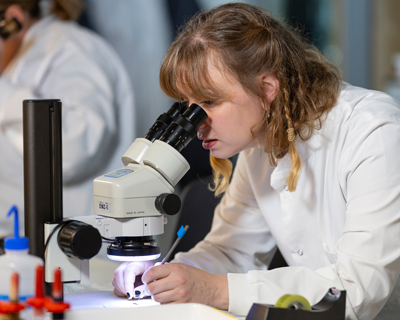Plant Health at the RHS: a very brief history
From saving daffodils and digging for victory to the rise of box caterpillar and wildlife gardening – key moments from over a century of scientific research
Plant health has been a key part of the RHS for well over a century. While there has been a plethora of research, new disease reports and new species discovered during that time, the core values of the Plant Health department have remained a constant.
In 1868, the RHS decided to appoint a scientific advisory board, in response to the number of scientific questions around horticulture discussed at the Fruit and Floral Committees. During the 20th century, the purpose of this advisory board broadened to include ‘diseases, pests and newly imported plants’.
It all started with a fungal canker
In 1784, botanist William Forsyth was working as the superintendent for the Kensington Royal Gardens. He had noticed the fruit trees in Kensington Palace were “in a very cankery and unfruitful state”. To treat the cankers, he concocted a plaster made of lime, dung, ashes and urine, which he claimed cured the tree defects.
This plaster received a mix of praise and criticism. Horticulturalist Thomas Andrew Knight heavily criticised the plaster, rebuffing Forsyth’s extreme claims – Forsyth was adamant that the plaster could be used to revive tree stumps. Knight’s criticisms and the subsequent controversy led to Forsyth not inviting Knight to the founding meeting of the RHS.
The ‘old’ laboratory and early scientific endeavours
As you approach the entrance to RHS Wisley, the first building you’ll notice is one we refer to now as the Old Laboratory. Established in 1907, this was the original home for horticultural science, with the aims of delivering research into ornamental horticulture as well as training for students. The construction of the laboratory enabled research to take place that was widely renowned.
First RHS entomologist: Harold Maxwell-Lefroy
After being appointed the first Professor of Entomology at Imperial College London in 1912, Maxwell-Lefroy was also given the position as the RHS’ first entomologist (insect specialist) in 1913. He taught at RHS Wisley, and one of his lectures was converted into a leaflet titled On Keeping Fruit Trees Clean, published by the RHS in 1916. This was reprinted six times up until 1942, and is still part of our library’s collection.
As a research student at RHS Wisley in 1916, James Kirkham Ramsbottom was asked to examine a puzzling disease that was seriously damaging the
Ramsbottom was able to determine that the cause of the disease was daffodil eelworm, a nematode identified as Ditylenchus dipsaci. A treatment was developed in which the bulbs are immersed in hot water, which successfully controlled the nematodes. This resulted in the invention of a copper bulb boiler, which is still used to this day.
This successful treatment saved the daffodil industry, and became widely used as a standard precaution in bulb production.
The groundings of the first RHS Plant Health team
Under the directorship of Frederick Chittenden in 1919, a new wave of scientists joined the RHS. This included entomologist George Fox Wilson and mycologist (fungal specialist) Walter John Dowson, alongside Norman Gould as assistant botanist.
George Fox Wilson worked as an assistant to the first RHS entomologist, Maxwell-Lefroy, before taking this position himself, where he served until his death in 1951.
Fox Wilson was the first to trial biological controls for glasshouse pests, studying Encarsia formosa – a parasitoid wasp – for the control of glasshouse whitefly. Encarsia is still used for this purpose today, in a horticultural landscape where biological controls are becoming ever more crucial in place of indiscriminate and ecologically disruptive pesticides.
Fox Wilson researched a diverse range of horticultural entomology, including
Plant Health team support Britain’s Dig for Victory
The RHS was involved quite heavily with the famous Dig for Victory campaign, and the Plant Health team at the time were a key part of that involvement. Courses were offered to members of the armed forces, as well as the Women’s Land Army, which included lectures on controlling vegetable diseases and George Fox Wilson teaching on vegetable pests.
Special courses were also arranged for the Royal Air Force, which focussed on food production, pests and diseases, and demonstrations of spraying machines.
Evolution of Plant Health in the last few decades
By the 1960s, the role of RHS scientific staff was advisory, and any research stemmed from problems arising out of the advisory work.
It was not until the 1970s that the RHS became more active around conservation issues, developing conservation policies and leaflets and becoming involved in issues such as pollution, the exploitation of peatlands, the use of endangered hardwoods, and the planting of


